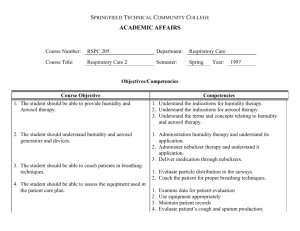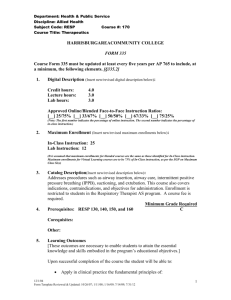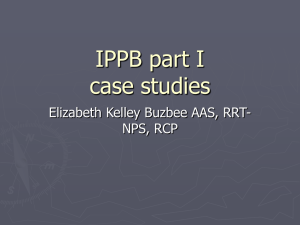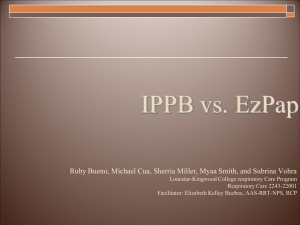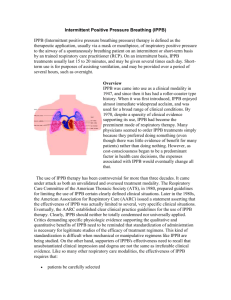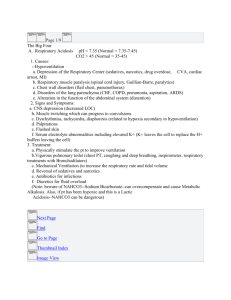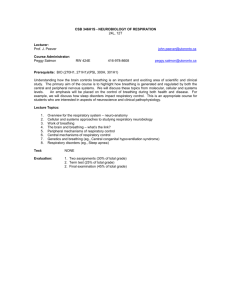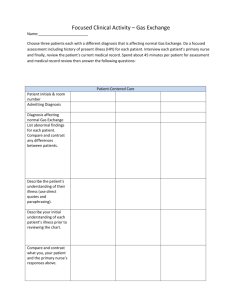Intermittent positive pressure breathing : 2003
advertisement
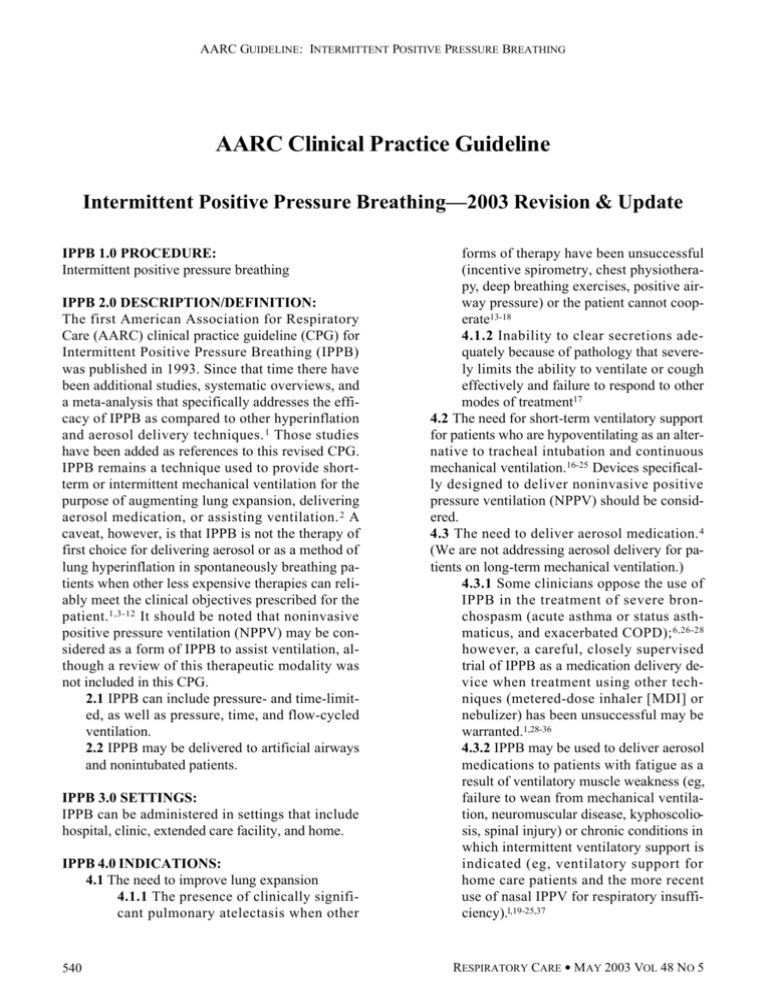
AARC GUIDELINE: INTERMITTENT POSITIVE PRESSURE BREATHING AARC Clinical Practice Guideline Intermittent Positive Pressure Breathing—2003 Revision & Update IPPB 1.0 PROCEDURE: Intermittent positive pressure breathing IPPB 2.0 DESCRIPTION/DEFINITION: The first American Association for Respiratory Care (AARC) clinical practice guideline (CPG) for Intermittent Positive Pressure Breathing (IPPB) was published in 1993. Since that time there have been additional studies, systematic overviews, and a meta-analysis that specifically addresses the efficacy of IPPB as compared to other hyperinflation and aerosol delivery techniques. 1 Those studies have been added as references to this revised CPG. IPPB remains a technique used to provide shortterm or intermittent mechanical ventilation for the purpose of augmenting lung expansion, delivering aerosol medication, or assisting ventilation. 2 A caveat, however, is that IPPB is not the therapy of first choice for delivering aerosol or as a method of lung hyperinflation in spontaneously breathing patients when other less expensive therapies can reliably meet the clinical objectives prescribed for the p a t i e n t .1 , 3 - 1 2 It should be noted that noninvasive positive pressure ventilation (NPPV) may be considered as a form of IPPB to assist ventilation, although a review of this therapeutic modality was not included in this CPG. 2.1 IPPB can include pressure- and time-limited, as well as pressure, time, and flow-cycled ventilation. 2.2 IPPB may be delivered to artificial airways and nonintubated patients. IPPB 3.0 SETTINGS: IPPB can be administered in settings that include hospital, clinic, extended care facility, and home. IPPB 4.0 INDICATIONS: 4.1 The need to improve lung expansion 4.1.1 The presence of clinically significant pulmonary atelectasis when other 540 forms of therapy have been unsuccessful (incentive spirometry, chest physiotherapy, deep breathing exercises, positive airway pressure) or the patient cannot cooperate13-18 4 . 1 . 2 Inability to clear secretions adequately because of pathology that severely limits the ability to ventilate or cough effectively and failure to respond to other modes of treatment17 4.2 The need for short-term ventilatory support for patients who are hypoventilating as an alternative to tracheal intubation and continuous mechanical ventilation.16-25 Devices specifically designed to deliver noninvasive positive pressure ventilation (NPPV) should be considered. 4.3 The need to deliver aerosol medication. 4 (We are not addressing aerosol delivery for patients on long-term mechanical ventilation.) 4.3.1 Some clinicians oppose the use of IPPB in the treatment of severe bronchospasm (acute asthma or status asthmaticus, and exacerbated COPD); 6 , 2 6 - 2 8 h o w e v e r, a careful, closely supervised trial of IPPB as a medication delivery device when treatment using other techniques (metered-dose inhaler [MDI] or nebulizer) has been unsuccessful may be warranted.1,28-36 4.3.2 IPPB may be used to deliver aerosol medications to patients with fatigue as a result of ventilatory muscle weakness (eg, failure to wean from mechanical ventilation, neuromuscular disease, kyphoscoliosis, spinal injury) or chronic conditions in which intermittent ventilatory support is indicated (eg, ventilatory support for home care patients and the more recent use of nasal IPPV for respiratory insufficiency).l,19-25,37 RESPIRATORY CARE • MAY 2003 VOL 48 NO 5 AARC GUIDELINE: INTERMITTENT POSITIVE PRESSURE BREATHING 4.3.3 In patients with severe hyperinflation, IPPB may decrease dyspnea and discomfort during nebulized therapy.38 IPPB 5.0 CONTRAINDICATIONS: There are several clinical situations in which IPPB should not be used. With the exception of untreated tension pneumothorax, most of these contraindications are relative:39 5.1 Tension pneumothorax (untreated) 5.2 Intracranial pressure (ICP) > 15 mm Hg 5.3 Hemodynamic instability 5.4 Recent facial, oral, or skull surgery 5.5 Tracheoesophageal fistula 5.6 Recent esophageal surgery 5.7 Active hemoptysis 5.8 Nausea 5.9 Air swallowing 5.10 Active untreated tuberculosis 5.11 Radiographic evidence of bleb 5.12 Singulation (hiccups) IPPB 6.0 HAZARDS/COMPLICATIONS: 6 . 1 Increased airway resistance and work of breathing40,41 6.2 Barotrauma, pneumothorax40 6.3 Nosocomial infection40 6.4 Hypocarbia4,42 6.5 Hemoptysis4,42 6.6 Hyperoxia when oxygen is the gas source40 6.7 Gastric distention40 6.8 Impaction of secretions (associated with inadequately humidified gas mixture)40 6.9 Psychological dependence40 6.10 Impedance of venous return40 6.11 Exacerbation of hypoxemia 6.12 Hypoventilation or hyperventilation 6.13 Increased mismatch of ventilation and perfusion 6.14 Air trapping, auto-PEEP, overdistended alveoli IPPB 7.0 LIMITATIONS OF PROCEDURE OR DEVICE: 7.1 All of the mechanical effects of IPPB are short-lived, lasting ≤ an hour after treatment.42-44 7.2 Based on the available literature, MDI or compressor-driven nebulizers should be considered the devices of choice for aerosol therapy to COPD and stable asthma patients.l,3-8 RESPIRATORY CARE • MAY 2003 VOL 48 NO 5 7 . 3 Only a very small percentage of the aerosolized medication optimally deposits in the airway.45 Delivery of a therapeutic medication dose via IPPB may require as much as a tenfold increase in medication amount when compared to MDIs.45-47 7 . 4 E fficacy of device for ventilation and aerosol delivery is technique-dependent (eg, coordination, breathing pattern, selection of appropriate inspiratory flow, peak pressure, inspiratory hold).48-59 7.5 Efficacy is dependent on the design of the device (eg, flow, volume, and pressure capability as well as aerosol output and particle size).48,50,60-62 7.6 IPPB is equipment- and labor-intensive as a method of delivery of aerosol.48,50,63-67 7 . 7 Limited portability, lack of instruction, and/or lack of 50-psi gas source may affect patient compliance. IPPB 8.0 ASSESSMENT OF NEED: 8.1 Presence of clinically significant atelectasis 8.2 Reduced pulmonary function as evidenced by reductions in timed volumes and vital capacity (eg, FEV 1 < 65% predicted, FVC < 70% predicted, MVV < 50% predicted,68 or VC < 10 mL/kg), precluding an effective cough 8.3 Neuromuscular disorders or kyphoscoliosis with associated decreases in lung volumes and capacities 8.4 Fatigue or muscle weakness with impending respiratory failure 8.5 Presence of acute severe bronchospasm or exacerbated COPD that fails to respond to other therapy 8.5.1 Based on proven therapeutic efficacy, variety of medications, and cost-effectiveness, the MDI with a spacing device or holding chamber should be the first method to consider for administration of aerosol.50,63-67,69,70 8.5.2 Regardless of the type of delivery device used (MDI with spacer or smallvolume, large-volume, or ultrasonic nebulizer), it is important to recognize that the dose of the drug needs to be titrated to give the maximum benefit.45,47 8.6 With demonstrated effectiveness, the patient’s preference for a positive pressure device 541 AARC GUIDELINE: INTERMITTENT POSITIVE PRESSURE BREATHING should be honored. 8.7 IPPB may be indicated in patients who are at risk for the development of atelectasis and are unable or unwilling to deep breathe without assistance.71 IPPB 9.0 ASSESSMENT OF OUTCOME: 9.1 For lung expansion therapy, a minimum delivered tidal volume of at least 1/3 of the predicted IC (1/3 x 50 mL/kg) has been suggested. This corresponds to approximately 1200 mL in a 70 kg adult patient.71 9.2 An increase in FEV1 or peak flow 9.3 Cough more effective with treatment 9.4 Secretion clearance enhanced as a consequence of deep breathing and coughing 9.5 Chest radiograph improved 9.6 Breath sounds improved 9.7 Favorable patient subjective response IPPB 10.0 RESOURCES: 10.1 Equipment: 10.1.1 IPPB devices can be pneumatically driven or electrically powered. They are usually categorized as patient-triggered, pressure- or flow-cycled mechanical ventilators.39 10.1.2 Most IPPB devices require a 45-55 psi gas pressure source (eg, compressed gas cylinder, bulk gas system, external or internal air compressor). 10.1.3 Single-use IPPB devices are now available for providing short-term or intermittent mechanical ventilation, augmenting hyperinflation and delivering aerosols. 10.1.3.1 Single-use IPPB devices are not equipped with a redundant pop-off valve and thus should not be used with an endotracheal tube, and used only cautiously with a mask. 1 0 . 1 . 3 . 2 Tidal volume may be determined by using the tidal volume chart included with single-use IPPB instructions. 1 0 . 1 . 3 . 3 For single-use IPPB equipment at home, the rental/purchase of a 50 psi gas source is usually necessary. 10.1.3.4 Limited research indicates that single-use IPPB may be a safe and ef- 542 fective method of delivering IPPB without the need for conventional IPPB capital equipment.72 10.1.4 IPPB circuitry includes large bore and connective tubing, nebulizer, adapters, and patient connection (mouthpiece, lip seal, mask, 15-mm ETT connector), and if needed, nose clips. 10.1.5 Tissues, emesis basin, or sputum cup for collecting or disposing of expectorated sputum 1 0 . 1 . 6 Gloves, gown, goggles, and/or mask with face shield as indicated 10.1.7 Volume measuring device (handheld spirometer or other volume-collecting bag) 10.1.8 Oral and/or endotracheal suction equipment 10.2 Personnel: A continuum of education and skill levels is required for personnel who administer IPPB therapy. Different clinical situations warrant the degree of training necessary to provide optimal respiratory care. 1 0 . 2 . 1 Level I caregiver may be the provider of service after Level II personnel have established need for a specific device by patient assessment, and after the first administration has been completed. Level I personnel must demonstrate: 10.2.1.1 Ability to prepare, measure, and mix medication 10.2.1.2 Proper technique for administration of medication 10.2.1.3 Proper use of equipment, including adjustment of machine settings to meet patient demands 10.2.1.4 Effective cleaning of equipment 10.2.1.5 Proper disposal of wastes 10.2.1.6 Ability to encourage effective breathing patterns and coughing techniques 10.2.1.7 Ability to modify technique (after communication with physician) in response to recognized complications and adverse reactions or change in severity of symptoms as determined by observation, ausculation, and vitalsigns determination 10.2.1.8 Ability to implement Standard RESPIRATORY CARE • MAY 2003 VOL 48 NO 5 AARC GUIDELINE: INTERMITTENT POSITIVE PRESSURE BREATHING Precautions and use proper infection control 10.2.2 Level II Personnel must exhibit all Level I skills and demonstrate: 1 0 . 2 . 2 . 1 Ability to perform physical exam—auscultation, inspection, percussion, and vital signs 10.2.2.2 Ability to assess patient condition and patient response to therapy 10.2.2.3 Ability to perform peak expiratory flowrate, spirometry, and ventilatory mechanics measurement 10.2.2.4 Proper use and knowledge of limitations of IPPB equipment and aerosol device and ability to fit mask and/or identify best application device for particular patient 1 0 . 2 . 2 . 5 Ability to recognize and respond to therapeutic changes, adverse response, and complications of aerosol medications 10.2.2.6 Ability to modify dosage of medication and/or frequency of administration as prescribed in response to severity of symptoms 10.2.2.7 Ability to negotiate care plan and modifications with physician and health care team 10.2.2.8 Understanding of effects of increased pressure on ventilation, perfusion, and sputum mobilization 10.2.2.9 Ability to modify technique in response to adverse reactions 1 0 . 2 . 2 . 1 0 Ability to instruct patient/ family/caregiver in goals of therapy, and: 10.2.2.10.1 Proper technique for administration 10.2.2.10.2 Proper use of equipment 10.2.2.10.3 Cleaning of equipment 10.2.2.10.4 Breathing patterns and coughing techniques 10.2.2.10.5 Recognition of communications and technique modification in response to adverse reactions 10.2.2.10.6 Frequency modification in response to severity of symptoms 10.2.2.11 Understanding and compliance with Standard Precautions and infection control issues related to clean- RESPIRATORY CARE • MAY 2003 VOL 48 NO 5 ing and maintaining equipment and handling of secretions and hazardous waste 10.2.3 Level III—Self-administration of IPPB. Patients who are to self-administer IPPB should demonstrate to the supervising clinician: 10.2.3.1 Proper technique for administration 10.2.3.2 Proper use of equipment 10.2.3.3 Proper cleaning of equipment 10.2.3.4 Ability to measure and mix medications 10.2.3.5 Optimal breathing patterns and coughing techniques 10.2.3.6 Technique modification in response to adverse reactions and duration or frequency modification in response to severity of symptoms IPPB 11.0 MONITORING: Items from the following list should be chosen as appropriate for the specific patient: 11.1 Performance of machine trigger sensitivity, peak pressure, flow setting, FIO2, inspiratory time, expiratory time, plateau pressure, PEEP 11.2 Respiratory rate 11.3 Delivered tidal volume 11.4 Pulse rate and rhythm from ECG if available 11 . 5 Patient subjective response to therapy: pain, discomfort, dyspnea 11.6 Sputum production: quantity, color, consistency 11.7 Mental function 11.8 Skin color 11.9 Breath sounds 11.10 Blood pressure 11.11 Arterial hemoglobin saturation by pulse oximetry (if hypoxemia is suspected) 11.12 Intracranial pressure (ICP) in patients for whom ICP is of critical importance 11.13 Chest radiograph IPPB 12.0 FREQUENCY: 12.1 Critical care: Every 1 to 6 hours for IPPB as tolerated. IPPB order should be re-evaluated at least every 24 hours based on assessments during individual treatments. 12.2 Acute/home care patients: 543 AARC GUIDELINE: INTERMITTENT POSITIVE PRESSURE BREATHING 12.2.1 Common strategies for IPPB vary from b.i.d. to q.i.d. Frequency should be determined by assessing patient response to therapy. 1 2 . 2 . 2 For acute care patients, order should be re-evaluated based on patient response to therapy at least every 72 hours or with any change of patient status. 1 2 . 2 . 3 Home care patients should be reevaluated/reinstructed periodically and with any change of status. IPPB 13.0 INFECTION CONTROL:50 1 3 . 1 Caregivers should implement Standard P r e c a u t i o n s7 3 and appropriate guidelines for prevention of tuberculosis transmission.74 13.2 Caregivers should observe all infection control guidelines posted for patient. 13.3 All reusable equipment should be disinfected between patients. 1 3 . 4 Nebulizers/IPPB circuits should be changed between patients, when visibly soiled, or according to institutional infection control policy. 1 3 . 5 IPPB machines/manifolds can be fitted with a scavenger or filter system to prevent aerosol from being released outside the immediate treatment areas.75 13.6 Nebulizers should not be rinsed with tap water between treatments, 7 6 , 7 7 but may be rinsed with sterile water or sterile saline and allowed to air dry. Revised by Helen M Sorenson MA RRT FAARC and David C Shelledy PhD RRT, University of Texas Health Science Center @ San Antonio, San Anto nio, Texas, and approved by the 2003 CPG Steering Committee 3. 4. 5. 6. 7. 8. 9. 10. 11. 12. 13. 14. 15. Original Publication: Respir Care 1993;38(11): 1189-1195. 16. REFERENCES 17. 1. Thomas JA, McIntosh JM. Are incentive spirometry, intermittent positive pressure breathing, and deep breathing exercises effective in the prevention of postoperative pulmonary complications after upper abdominal surgery? A systematic overview and meta-analysis. Phys Ther 1994;74(1):3-10; discussion 10-16. 2. Agency for Health Care Policy and Research (AHCPR). 544 18. 19. Health Technology Reports: intermittent positive pressure breathing (IPPB) therapy. 1991, Number 1. The IPPB Trial Group. Intermittent positive pressure breathing therapy of chronic obstructive pulmonary disease: a clinical trial. Ann Intern Med 1983;99(5):612-620. Ostrow DN. Managing chronic airflow obstruction. Part II. Geriatrics 1985;40(3):51-53,56,59 passim. Gonzalez ER, Burke TG. Review of the status of intermittent positive pressure breathing therapy. Drug Intell Clin Pharm 1984;18(12):974-976. Pedersen JZ, Bundgaard A. Comparative efficacy of different methods of nebulising terbutaline. Eur J Clin Pharmacol 1983;25(6):739-742. Weber RW, Petty WE, Nelson HS. Aerosolized terbutaline in asthmatics: comparison of dosage strength, schedule, and method of administration. J Allergy Clin Immunol 1979;63(2):116-121. Moore RB, Cotton EK, Pinney MA. The effect of intermittent positive-pressure breathing on airway resistance in normal and asthmatic children. J Allergy Clin Immunol 1972;49(3):137-141. Dolovich MB, Killian D, Wolff RK, Obminski G, Newhouse MT. Pulmonary aerosol deposition in chronic bronchitis: intermittent positive pressure breathing versus quiet breathing. Am Rev Respir Dis 1977;115(3): 397-402. Oikkonen M, Karjalainen K, Kahara V, Kuosa R, Schavikin L. Comparison of incentive spirometry and intermittent positive pressure breathing after coronary artery bypass graft. Chest 1991;99(1):60-65. Indihar FJ, Forsberg DP, Adams AB. A prospective comparison of three procedures used in attempts to prevent postoperative pulmonary complications. Respir Care 1982;27(5):564-568. Celli BR, Rodriguez KS, Snider GL. A controlled trial of intermittent positive pressure breathing, incentive spirometry, and deep breathing exercises in preventing pulmonary complications after abdominal surgery. Am Rev Respir Dis 1984;130(1):12-15. Bartlett RH, Gazzaniga AB, Geraghty TR. Respiratory maneuvers to prevent postoperative pulmonary complications: a critical review. JAMA 1973;224(7):1017-1021. Bartlett RH. Respiratory therapy to prevent pulmonary complications of surgery. Respir Care 1984;29(6):667-679. Marini JJ. Postoperative atelectasis: pathophysiology, clinical importance, and principles of management. Respir Care 1984;29(5):516-528. American Thoracic Society (ATS). As quoted in intermittent positive pressure breathing therapy. AHCPR Health Technology Assessment Reports, 1991, No. 1:5. National Association of Medical Directors of Respiratory Care (NAMDRC). As quoted in intermittent positive pressure breathing therapy. AHCPR Health Technology Assessment Reports, 1991, No. 1:6. American College of Chest Physicians (ACCP). As quoted in intermittent positive pressure breathing therapy. AHCPR Health Technology Assessment Reports, 1991, No. 1:6. De Troyer A, Deisser P. The effects of intermittent posi- RESPIRATORY CARE • MAY 2003 VOL 48 NO 5 AARC GUIDELINE: INTERMITTENT POSITIVE PRESSURE BREATHING 20. 21. 22. 23. 24. 25. 26. 27. 28. 29. 30. 31. 32. 33. 34. 35. tive pressure breathing on patients with respiratory muscle weakness. Am Rev Respir Dis 1981;124(2):132-137. Rodenstein DO, Stanescu DC, Delguste P, Liistro G, Aubert-Tulkens G. Adaptation to intermittent positive pressure ventilation applied through the nose during day and night. Eur Respir J 1989;2(5):473-478. Brochard L, Harf A, Lorino H, Lemaire F. Inspiratory pressure support prevents diaphragmatic fatigue during weaning from mechanical ventilation. Am Rev Respir Dis 1989;139(2):513-521. McKim DA, Dales RE, Lefebvre GG, Proulx M. Nocturnal positive-pressure nasal ventilation for respiratory failure during pregnancy. Can Med Assoc J 1988;139(11):1069-1071. Bach JR, Alba A, Mosher R, Delaubier A. Intermittent positive pressure ventilation via nasal access in the management of respiratory insufficiency. Chest 1987;92(1):168-170. Kinnear WJ, Shneerson JM. Assisted ventilation at home: is it worth considering? Br J Dis Chest 1985;79(4):313-351. Splaingard ML, Frates RC Jr, Jefferson LS, Rosen CL, Harrison GM. Home negative pressure ventilation report of 20 years of experience in patients with neuromuscular disease. Arch Phys Med Rehabil 1985;66(4):239-242. Fergusson RJ, Carmichael J, Rafferty P, Willey RF, Crompton GK, Grant IW. Nebulized salbutamol in lifethreatening asthma: is IPPB necessary? Br J Dis Chest 1983;77(3):255-261. Loren M, Chai H, Miklich D, Barwise G. Comparison between simple nebulization and intermittent positivepressure in asthmatic children with severe bronchospasm. Chest 1977;72(2):145-147. Webber BA, Shenfield GM, Paterson JW. A comparison of three different techniques for giving nebulized albuterol to asthmatic patients. Am Rev Respir Dis 1974;109(2):293-295. Eggertsen SC. Intermittent positive pressure breathing and the treatment of acute asthma. J Fam Pract 1983;16(5):909-913. Choo-Kang YF, Grant IW. Comparison of two methods of administering bronchodilator aerosol to asthmatic patients. Br Med J 1975;2(5963):119-120. Aelony Y. “Noninvasive” oral treatment of asthma in the emergency room. Am J Med 1985;78(6 Pt 2):929-936. Cayton RM, Webber B, Paterson JW, Clark TJ. A comparison of salbutamol given by pressure-packed aerosol or nebulization via IPPB in acute asthma. Br J Dis Chest 1978;72(3):222-224. Webber BA, Collins JV, Branthwaite MA. Severe acute asthma: a comparison of three methods of inhaling salbutamol. Br J Dis Chest 1982;76(1): 69-74. Chang N, Levison H. The effect of a nebulized bronchodilator administered with or without intermittent positive pressure breathing on ventilatory function in children with cystic fibrosis and asthma. Am Rev Respir Dis 1972;106(6):867-872. Branscomb BV. Metaproterenol solution in the treat- RESPIRATORY CARE • MAY 2003 VOL 48 NO 5 36. 37. 38. 39. 40. 41. 42. 43. 44. 45. 46. 47. 48. 49. 50. 51. 52. 53. 54. 55. ment of asthmatic patients by intermittent positive pressure breathing. J Clin Pharmacol 1982;22(5-6):231-235. Anderson PB, Goude A, Peake MD. Comparison of salbutamol given by intermittent positive-pressure breathing and pressure-packed aerosol in chronic asthma. Thorax 1982;37(8):612-616. Denehy L, Berney S. The use of positive pressure devices by physiotherapists. Eur Respir J 2001;17(4):821-829. Janssens JP, de Muralt B, Titelion V. Management of dyspnea in severe chronic obstructive pulmonary disease. J Pain Sympt Manage 2000;19(5):378-392. Scanlan CL, Wilkins RL, Stoller JK. Egan’s fundamentals of respiratory care, 7th ed. St Louis: Mosby;1999:777-782. Shapiro BA, Peterson J, Carne RD. Complications of mechanical aids to intermittent lung inflation. Respir Care 1982;27(4):467-470. Mancebo J, Isabey D, Lorino H, Lofaso F, Lemaire F, Brochard L. Comparative effects of pressure support ventilation and intermittent positive pressure breathing (IPPB) in non-intubated healthy subjects. Eur Respir J 1995;8(11):1901-1909. Schilling JP, Kasik JE. Intermittent positive pressure breathing: a continuing controversy. J Iowa Med Soc 1980;70(3):99-100,102-103. Branson RD, Campbell RS. Sighs: wasted breath or breath of fresh air? Respir Care 1992;37(5):462-468. Stiller K, Simionato R, Rice K, Hall B. The effect of intermittent positive pressure breathing on lung volumes in acute quadriparesis. Paraplegia 1992;30(2):121-126. Newman SP. Aerosol deposition considerations in inhalation therapy. Chest 1985;88(2 Suppl):152S-160S. DP. Dosing strategies for bronchodilator aerosol delivery. Respir Care 1991;36(9):977-988. Nelson HS, Spector SL, Whitsett TL, George RB, Dwek JH. The bronchodilator response to inhalation of increasing doses of aerosolized albuterol. J Allergy Clin Immunol 1983;72(4):371-375. Dolovich M. Clinical aspects of aerosol physics. Respir Care 1991;36(9):931-938. Kacmarek RM, Hess D. The interface between patient and aerosol generator. Respir Care 1991;36(9):952-976. American Association for Respiratory Care. AARC Clinical Practice Guideline: Selection of an aerosol delivery device. Respir Care 1992;37(8):891-897. Allen SC, Prior A. What determines whether an elderly patient can use a metered dose inhaler correctly? Br J Dis Chest 1986;80(1):45-49. Lindgren S, Bake B, Larsson S. Clinical consequences of inadequate inhalation technique in asthma therapy. Eur J Respir Dis 1987;70(2):93-98. Oprehek J, Gayard P, Grimaud C, Charpin J. Patient error in use of bronchodilator metered aerosols. Br Med J 1976;1(6001):76. Guidry GG, Brown WD, Stogner SW, George RB. Incorrect use of metered dose inhalers by medical personnel. Chest 1992;101(1):31-33. Crompton GK. Problems patients have using pressurized aerosol inhalers. Eur J Respir Dis Suppl 1982;119:101-104. 545 AARC GUIDELINE: INTERMITTENT POSITIVE PRESSURE BREATHING 56. O’Connell MB, Hewitt JM, Lackner TE. Consistency of evaluators assessing inhaler technique. Ann Allergy 1991;67(6):603-608. 57. De Tullio PL, Corson ME. Effect of pharmacist counseling on ambulatory patients’ use of aerosolized bronchodilators. Am J Hosp Pharm 1987;44(8):1802-1806. 58. Self TH, Brooks JB, Lieberman P. Ryan MR. The value of demonstration and role of the pharmacist in teaching the correct use of pressurized bronchodilators. Can Med Assoc J 1983;128(2):129-131. 59. Woodcock A. Training aid for pressurized inhalers. Br J Dis Chest 1980;74(4):395-397. 60. Sterk PJ, Plomp A, van de Vate JF, Quanjer PH. Physical properties of aerosols produced by several jet- and ultrasonic nebulizers. Bull Eur Physiopathol Respir 1984;20(1):65-72. 61. Alvine GF, Rodgers P, Fitzsimmons KM, Ahrens RC. Disposable jet nebulizers: how reliable are they? Chest 1992;101(2):316-319. 62. Newman SP. Aerosol generators and delivery systems. Respir Care 1991;36(9):939-951. 63. Mestitz H, Copland JM, McDonald CF. Comparison of outpatient nebulized vs metered dose inhaler terbutaline in chronic airflow obstruction. Chest 1989;96(6):1237-1240. 64. Bowton DL, Goldsmith WM, Haponik EF. Substitution of metered-dose inhalers for hand-held nebulizers: success and cost savings in a large, acute-care hospital. Chest 1992;101(2):305-308. 65. Tenholder MF, Bryson MJ, Whitlock WL. A model for conversion from small volume nebulizer to metered dose inhaler aerosol therapy. Chest 1992;101(3):634-637. 66. Jasper AC, Mohsenifar Z, Kahan S, Goldberg HS, Koerner SK. Cost-benefit comparison of aerosol bronchodilator delivery methods in hospitalized patients. Chest 1987;91(4):614-618. 67. Summer W, Elston R, Tharpe L, Nelson S, Haponik EF. Aerosol bronchodilator delivery methods: relative impact on pulmonary function and cost of respiratory care. Arch Intern Med 1989;149(3):618-623. 68. Schoonover G, Olsen GN. Pulmonary function testing in the preoperative period: a review of the literature. J Clin Surg 1982;1:125-138. 69. Ruffin RE, Kenworthy MC, Newhouse MT. Response of asthmatic patients to fenoterol inhalation: a method of quantifying the airway bronchodilator dose. Clin Pharmacol Ther 1978;23(3):338-345. 70. Berry RB, Shinto RA, Wong FH, Despars JA, Light RW. Nebulizer vs spacer for bronchodilator delivery in patients hospitalized for acute exacerbations of COPD. Chest 1989;96(6):1241-1246. 71. Shelledy DC, Mikles, SP. Patient assessment and respiratory care plan development. In: Mishoe SC, Welch MA Jr, editors. Critical thinking in respiratory care. New York: The McGraw-Hill Companies; 2002. 72. Huff S. Comparison of the measured tidal volume vs the calculated tidal volume in the Piper-IPPB (abstract). Respir Care 2000;45(8):1012. 73. Bolyard EA, Tablan OC, Williams WW, Pearson ML, Shapiro CN, Deitchmann SD. Guideline for infection control in healthcare personnel, 1998. Hospital Infection Control Practices Advisory Committee. Infect Control Hosp Epidemiol 1998;19(6):4407-4462. Erratum in: In fect Control Hosp Epidemiol 1998;19(7):4493 74. Guidelines for preventing the transmission of Mycobac terium tuberculosis in health-care facilities, 1994. Centers for Disease Control and Prevention. MMWR Recomm Rep 1994 Oct 28;43(RR-13):1-132. 75. American Association for Respiratory Care. AARC Clinical Practice Guideline: Selection of a device for delivery of aerosol to the lung parenchyma. Respir Care 1996;41(7):647-653. 76. Brady MT. Nosocomial legionnaires disease in a children’s hospital. J Pediatr 1989;115(1):46-50. 77. Mastro TD, Fields BS, Breiman RF, Campbell J, Plikaytis BD, Spika JS. Nosocomial Legionnaires’ disease and use of medication nebulizers. J Infect Dis 1991;163(3):667-671. ADDITIONAL BIBLIOGRAPHY Cissik JH, Bode FR, Smith JA. Double-blind crossover study of five bronchodilator medications and two delivery methods in stable asthma: is there a best combination for use in the pulmonary laboratory? Chest 1986;90(4):489-493. Jenkins SC, Heaton RW, Fulton TJ, Moxham J. Comparison of domiciliary nebulized salbutamol and salbutamol from a metered-dose inhaler in stable chronic airflow limitation. Chest 1987;91(6):804-807. Levison H, Reilly PA, Worsley GH. Spacing devices and metered-dose inhalers in childhood asthma. J Pediatr 1985;107(5):662-668. Melville C, Phelan PD, Landau LI. Nebulised fenoterol compared with metered aerosol. Arch Dis Child 1985;60(3):257-259. Morgan MDL, Singh BV, Frame MH, Williams SJ. Terbutaline aerosol given through pear spacer in acute severe asthma. Br Med J (Clin Res Ed) 1982;285(6345):849-850. O’Reilly JF, Gould G, Kendrick AH, Laszlo G. Domiciliary comparison of terbutaline treatment by metered dose inhaler with and without conical spacer in severe and moderately severe chronic asthma. Thorax 1986;41(10):766-770. Sackner MA, Kim CS. Recent advances in the management of obstructive airways disease: auxiliary MDI aerosol delivery systems. Chest 1985;88(2 Suppl):161S-170S. Smetana GW. Strategies to reduce postoperative pulmonary complications. UpToDate Online 10.1. December 2001. Available on-line [http:// www.utdol.com]. Turner JR, Corkery KJ, Eckman D, Gelb AM, Lipavsky A, Sheppard D. Equivalence of continuous flow nebulizer and metered-dose inhaler with reservoir bag for treatment of acute airflow obstruction. Chest 1988;93(3):476-481. Interested persons may photocopy these Guidelines for noncommercial purposes of scientific or educational advancement. Please credit AARC and RESPIRATORY CARE Journal. All of the AARC CPGs may be downloaded at no charge from http://www.rcjournal.com/online/ 546 RESPIRATORY CARE • MAY 2003 VOL 48 NO 5
